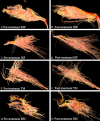Efficacy and safety of Tuina and intermediate frequency electrotherapy for frozen shoulder: MRI-based observation evidence
- PMID: 37056812
- PMCID: PMC10086926
Efficacy and safety of Tuina and intermediate frequency electrotherapy for frozen shoulder: MRI-based observation evidence
Abstract
Background: Tuina and Intermediate Frequency (IF) electrotherapy are commonly used treatments for frozen shoulder (FS). This study aimed to compare the clinical efficacy of Tuina and IF electrotherapy in the treatment of stage II frozen shoulder and to provide evidence-based treatment for FS.
Methods: The FS patients were randomized into two groups, the observation group, which received Tuina, and the control group, which received IF electrotherapy. The total treatment duration was 20 minutes per treatment, 3 times per week; the treatment period was 6 weeks. Assessments were performed at baseline, 3 weeks, 6 weeks, and 16 weeks after follow-up. Primary assessments included visual analog scale (VAS), Constant-Murley scale (CMS), and secondary assessments included shoulder MRI, rotator cuff muscle diffusion tensor imaging (DTI).
Results: A total of 57 patients participated in this study, in the observation group (n = 29) and the control group (n = 28). At the end of the 3rd and 6th weeks of treatment, Tuina was significantly more effective than IF electrotherapy in reducing the VAS score and improving the Constant-Murley total score (P<0.05), but there was no significant difference in scores between the two groups at the 16-week follow-up (P>0.05). MRI results in both groups: compared to the control group, the observation group had better results in reducing the degree of periapical edema and reducing the thickness of the axillary humeral capsule (P<0.05); and the observation group had significantly more efficacy than the control group in improving the diffusion state of water molecules in the rotator cuff muscles (P<0.05).
Conclusion: Tuina is more effective than IF electrotherapy in improving the symptoms of FS patients as it can rapidly relieve the pain and restore the function of the affected shoulder, reduce the edema of the shoulder capsule, restore the function of the rotator cuff muscles, and shorten the natural course of FS. Name of the registry: This study was registered in the Shandong University of Traditional Chinese Medicine Affiliated Hospital; Grant No. (2021) Lun Audit No. (033) - KY; Date of registration: 2021.4.27.
Keywords: Frozen shoulder; IF electrotherapy; MRI; RCT; Tuina.
AJTR Copyright © 2023.
Conflict of interest statement
None.
Figures





Similar articles
-
Effect of Preoperative Frozen Shoulder on Clinical Outcomes After Arthroscopic Rotator Cuff Repair.Orthop J Sports Med. 2020 Jul 24;8(7):2325967120934449. doi: 10.1177/2325967120934449. eCollection 2020 Jul. Orthop J Sports Med. 2020. PMID: 32782902 Free PMC article.
-
Cerebral mechanism of Tuina analgesia in management of knee osteoarthritis using multimodal MRI: study protocol for a randomised controlled trial.Trials. 2022 Aug 19;23(1):694. doi: 10.1186/s13063-022-06633-x. Trials. 2022. PMID: 35986403 Free PMC article.
-
[Comparison of the effectiveness of the long head of the biceps tendon with or without proximal amputation after arthroscopic repair of the rotator cuff].Zhongguo Xiu Fu Chong Jian Wai Ke Za Zhi. 2022 Jul 15;36(7):845-852. doi: 10.7507/1002-1892.202203056. Zhongguo Xiu Fu Chong Jian Wai Ke Za Zhi. 2022. PMID: 35848181 Free PMC article. Chinese.
-
Subacromial decompression surgery for rotator cuff disease.Cochrane Database Syst Rev. 2019 Jan 17;1(1):CD005619. doi: 10.1002/14651858.CD005619.pub3. Cochrane Database Syst Rev. 2019. PMID: 30707445 Free PMC article.
-
Does Distal Clavicle Resection Decrease Pain or Improve Shoulder Function in Patients With Acromioclavicular Joint Arthritis and Rotator Cuff Tears? A Meta-analysis.Clin Orthop Relat Res. 2018 Dec;476(12):2402-2414. doi: 10.1097/CORR.0000000000000424. Clin Orthop Relat Res. 2018. PMID: 30334833 Free PMC article.
Cited by
-
Proteomics and phosphoproteomics to study Tuina reverses capsule fibrosis in frozen shoulder: a research report based on rats.Sci Rep. 2024 Jan 5;14(1):661. doi: 10.1038/s41598-023-50904-9. Sci Rep. 2024. PMID: 38182704 Free PMC article.
References
-
- Brun SP. Idiopathic frozen shoulder. Aust J Gen Pract. 2019;48:757–761. - PubMed
-
- Kelley MJ, Shaffer MA, Kuhn JE, Michener LA, Seitz AL, Uhl TL, Godges JJ, McClure PW. Shoulder pain and mobility deficits: adhesive capsulitis. J Orthop Sports Phys Ther. 2013;43:A1–31. - PubMed
-
- Neviaser AS, Neviaser RJ. Adhesive capsulitis of the shoulder. J Am Acad Orthop Surg. 2011;19:536–542. - PubMed
-
- van den Hout WB, Vermeulen HM, Rozing PM, Vliet Vlieland TP. Impact of adhesive capsulitis and economic evaluation of high-grade and low-grade mobilisation techniques. Aust J Physiother. 2005;51:141–149. - PubMed
LinkOut - more resources
Full Text Sources
Miscellaneous
